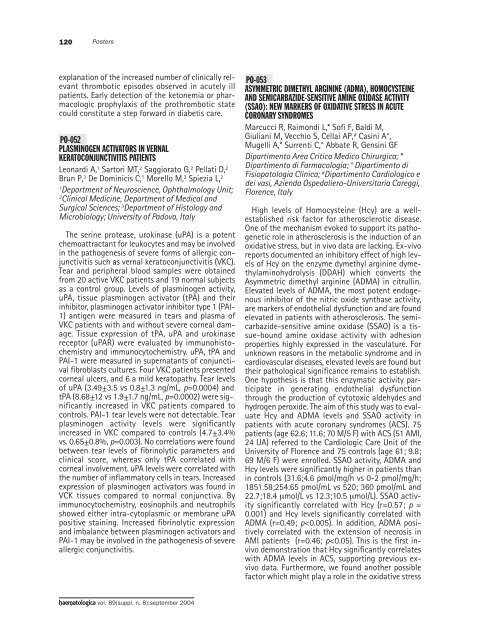Haematologica 2004;89: supplement no. 8 - Supplements ...
Haematologica 2004;89: supplement no. 8 - Supplements ...
Haematologica 2004;89: supplement no. 8 - Supplements ...
- No tags were found...
Create successful ePaper yourself
Turn your PDF publications into a flip-book with our unique Google optimized e-Paper software.
120Postersexplanation of the increased number of clinically relevantthrombotic episodes observed in acutely illpatients. Early detection of the ketonemia or pharmacologicprophylaxis of the prothrombotic statecould constitute a step forward in diabetis care.PO-052PLASMINOGEN ACTIVATORS IN VERNALKERATOCONJUNCTIVITIS PATIENTSLeonardi A, 1 Sartori MT, 2 Saggiorato G, 2 Pellati D, 2Brun P, 3 De Dominicis C, 1 Morello M, 2 Spiezia L, 21Department of Neuroscience, Ophthalmology Unit;2Clinical Medicine, Department of Medical andSurgical Sciences; 3 Department of Histology andMicrobiology; University of Padova, ItalyThe serine protease, urokinase (uPA) is a potentchemoattractant for leukocytes and may be involvedin the pathogenesis of severe forms of allergic conjunctivitissuch as vernal keratoconjunctivitis (VKC).Tear and peripheral blood samples were obtainedfrom 20 active VKC patients and 19 <strong>no</strong>rmal subjectsas a control group. Levels of plasmi<strong>no</strong>gen activity,uPA, tissue plasmi<strong>no</strong>gen activator (tPA) and theirinhibitor, plasmi<strong>no</strong>gen activator inhibitor type 1 (PAI-1) antigen were measured in tears and plasma ofVKC patients with and without severe corneal damage.Tissue expression of tPA, uPA and urokinasereceptor (uPAR) were evaluated by immu<strong>no</strong>histochemistryand immu<strong>no</strong>cytochemistry. uPA, tPA andPAI-1 were measured in supernatants of conjunctivalfibroblasts cultures. Four VKC patients presentedcorneal ulcers, and 6 a mild keratopathy. Tear levelsof uPA (3.49±3.5 vs 0.8±1.3 ng/mL, p=0.0004) andtPA (8.68±12 vs 1.9±1.7 ng/mL, p=0.0002) were significantlyincreased in VKC patients compared tocontrols. PAI-1 tear levels were <strong>no</strong>t detectable. Tearplasmi<strong>no</strong>gen activity levels were significantlyincreased in VKC compared to controls (4.7±3.4%vs. 0.65±0.8%, p=0.003). No correlations were foundbetween tear levels of fibri<strong>no</strong>lytic parameters andclinical score, whereas only tPA correlated withcorneal involvement. uPA levels were correlated withthe number of inflammatory cells in tears. Increasedexpression of plasmi<strong>no</strong>gen activators was found inVCK tissues compared to <strong>no</strong>rmal conjunctiva. Byimmu<strong>no</strong>cytochemistry, eosi<strong>no</strong>phils and neutrophilsshowed either intra-cytoplasmic or membrane uPApositive staining. Increased fibri<strong>no</strong>lytic expressionand imbalance between plasmi<strong>no</strong>gen activators andPAI-1 may be involved in the pathogenesis of severeallergic conjunctivitis.PO-053ASYMMETRIC DIMETHYL ARGININE (ADMA), HOMOCYSTEINEAND SEMICARBAZIDE-SENSITIVE AMINE OXIDASE ACTIVITY(SSAO): NEW MARKERS OF OXIDATIVE STRESS IN ACUTECORONARY SYNDROMESMarcucci R, Raimondi L,* Sofi F, Baldi M,Giuliani M, Vecchio S, Cellai AP, # Casini A°,Mugelli A,* Surrenti C,° Abbate R, Gensini GFDipartimento Area Critica Medico Chirurgica; *Dipartimento di Farmacologia; ° Dipartimento diFisiopatologia Clinica; # Dipartimento Cardiologico edei vasi, Azienda Ospedaliero-Universitaria Careggi,Florence, ItalyHigh levels of Homocysteine (Hcy) are a wellestablishedrisk factor for atherosclerotic disease.One of the mechanism evoked to support its pathogeneticrole in atherosclerosis is the induction of a<strong>no</strong>xidative stress, but in vivo data are lacking. Ex-vivoreports documented an inhibitory effect of high levelsof Hcy on the enzyme dymethyl arginine dymethylami<strong>no</strong>hydrolysis(DDAH) which converts theAsymmetric dimethyl arginine (ADMA) in citrullin.Elevated levels of ADMA, the most potent endoge<strong>no</strong>usinhibitor of the nitric oxide synthase activity,are markers of endothelial dysfunction and are foundelevated in patients with atherosclerosis. The semicarbazide-sensitiveamine oxidase (SSAO) is a tissue-boundamine oxidase activity with adhesionproperties highly expressed in the vasculature. Forunk<strong>no</strong>wn reasons in the metabolic syndrome and incardiovascular diseases, elevated levels are found buttheir pathological significance remains to establish.One hypothesis is that this enzymatic activity participatein generating endothelial dysfunctionthrough the production of cytotoxic aldehydes andhydrogen peroxide. The aim of this study was to evaluateHcy and ADMA levels and SSAO activity inpatients with acute coronary syndromes (ACS). 75patients (age 62.6; 11.6; 70 M/5 F) with ACS (51 AMI,24 UA) referred to the Cardiologic Care Unit of theUniversity of Florence and 75 controls (age 61; 9.8;69 M/6 F) were enrolled. SSAO activity, ADMA andHcy levels were significantly higher in patients thanin controls (31.6;4.6 pmol/mg/h vs 0-2 pmol/mg/h;1851.58;254.65 pmol/mL vs 520; 360 pmol/mL and22.7;18.4 µmol/L vs 12.3;10.5 µmol/L). SSAO activitysignificantly correlated with Hcy (r=0.57; p =0.001) and Hcy levels significantly correlated withADMA (r=0.49; p
















